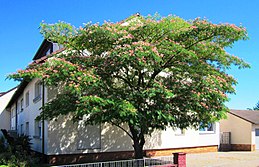
Albizia julibrissin

Albizia julibrissin (Persian silk tree, pink silk tree) is a species of tree in the family Fabaceae, native to southwestern and eastern Asia. The genus is named after the Italian nobleman Filippo degli Albizzi, who introduced it to Europe in the mid-18th century, and it is sometimes incorrectly spelled Albizzia. The specific epithet julibrissin is a corruption of the Persian word gul-i abrisham (گل ابریشم) which means 'silk flower' (from gul گل 'flower' + abrisham ابریشم 'silk'). Albizia julibrissin was described by Antonio Durazzini. John Gilbert Baker used the same scientific name to refer to Prain's Albizia kalkora, the Mimosa kalkora of William Roxburgh. Albizia julibrissin is known by a wide variety of common names, such as Persian silk tree or pink siris. It is also called Lenkoran acacia or bastard tamarind, though it is not too closely related to either genus. The species is usually called 'silk tree' or 'mimosa' in the United States, which is misleading - the former name can refer to any species of Albizia which is most common in any one locale. And, although once included in Mimosa, neither is it very close to the Mimoseae. To add to the confusion, several species of Acacia, notably Acacia baileyana and Acacia dealbata, are also known as 'mimosa' (especially in floristry), and many Fabaceae trees with highly divided leaves are called thus in horticulture. Its leaves slowly close during the night and during periods of rain, the leaflets bowing downward; thus its modern Persian name shabkhosb (شبخسب) means 'night sleeper'. In Japan its common names are nemunoki, nemurinoki and nenenoki which all mean 'sleeping tree'. Nemu tree is a partial translation of nemunoki. A. julibrissin is a small deciduous tree growing to 5–16 m (16–52 ft) tall, with a broad crown of level or arching branches. The bark is dark greenish grey in colour and striped vertically as it gets older, The leaves are bipinnate, 20–45 cm (7.9–17.7 in) long and 12–25 cm (4.7–9.8 in) broad, divided into 6–12 pairs of pinnae, each with 20–30 pairs of leaflets; the leaflets are oblong, 1–1.5 cm (0.39–0.59 in) long and 2–4 cm (0.79–1.57 in) broad. The flowers are produced throughout the summer in dense inflorescences, the individual flowers with small calyx and corolla (except the central ones), and a tight cluster of stamens 2–3 cm long, white or pink with a white base, looking like silky threads. They have been observed to be attractive to bees, butterflies and hummingbirds. The fruit is a flat brown pod 10–20 cm (3.9–7.9 in) long and 2–2.5 cm (0.79–0.98 in) broad, containing several seeds inside. There are two varieties: Original habitats of the tree include regions from Iran (Persia) and the Republic of Azerbaijan to China and Korea.
